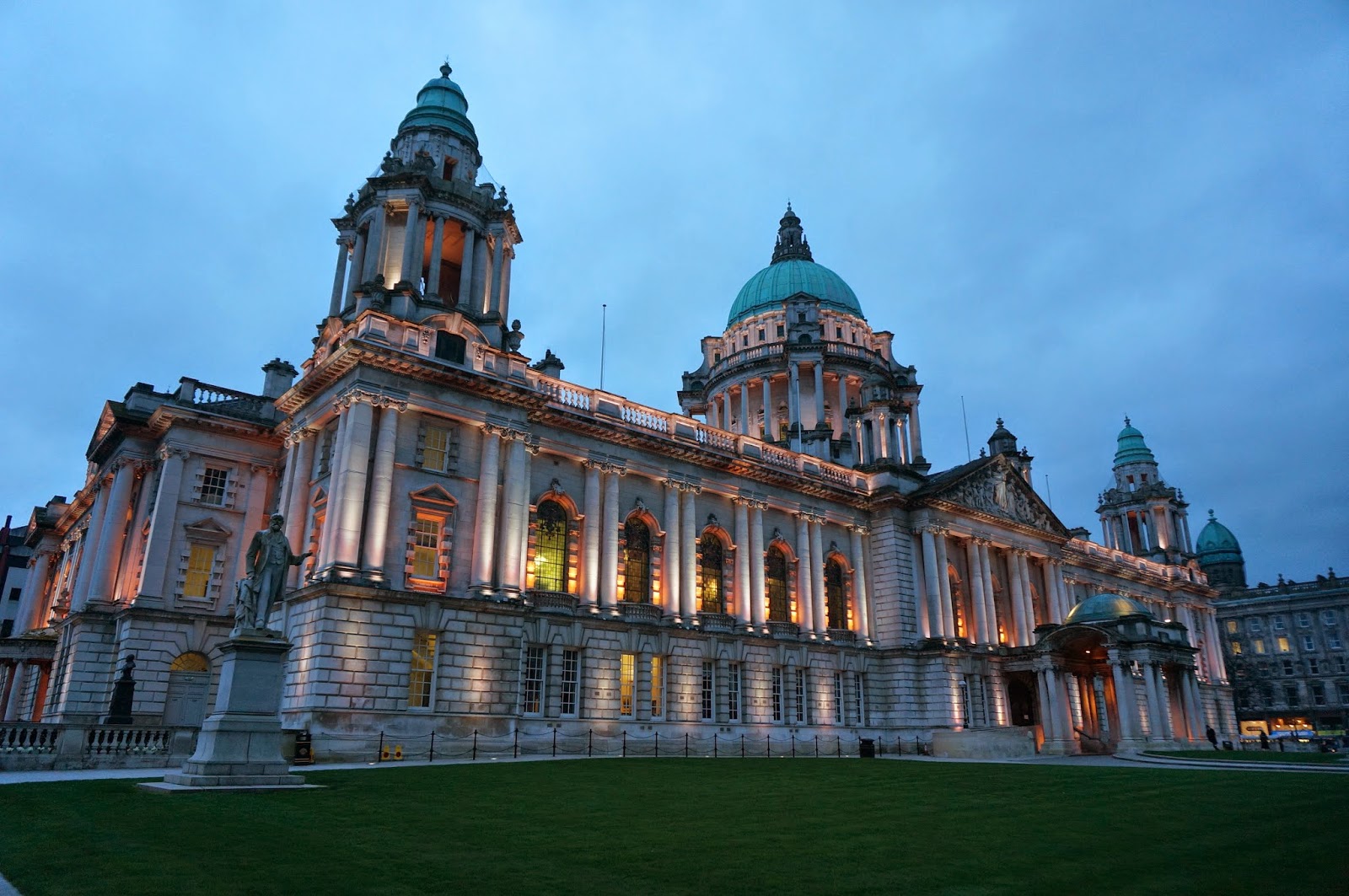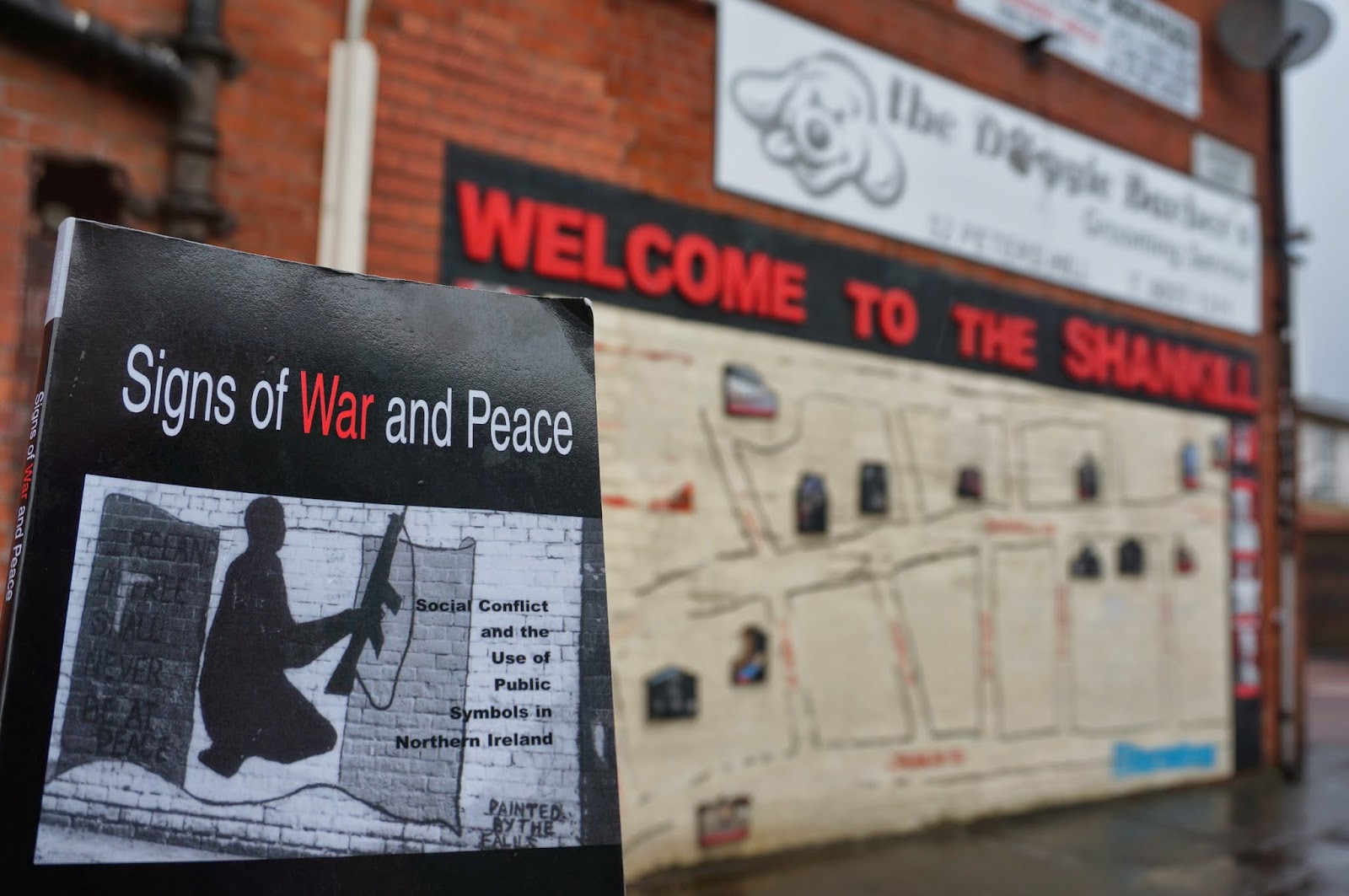 |
| Belfast City Hall |
As a sophomore in undergraduate university, we read a book for class about the public displays of national identity in Northern Ireland. Everyone in our class enjoyed the book and the perspective it brought to interpreting how nationalism can be displayed and the effects this has within communities. The book was
Signs of War and Peace by Jack Santino. Since reading about this in undergrad, I decided that if I ever had the chance to go to Belfast, I wanted to see some of the sights Santino describes.
 |
| Beginning of the tour, in the Shankhill |
Well, I finally made it to Belfast, some six years after reading the book in class. Since the end of the Troubles, Belfast's tourism industry has been growing. Downtown near City Hall, it seems as though you'd never know the Troubles took place if you were previously unaware of the history. However, the wounds are slower to heal and still raw in west Belfast (and other parts of the city). Because of the unique political history, there are actually various "black taxi" tours where a driver will take you in the taxi around west Belfast to see the famous murals on each side of the Peace Wall. There are actually several companies that drive, and you can check out some options
here,
here, and
here. There is also a fantastic map of the
locations of the murals around the city
here, in case you'd rather walk all over.
 |
| King William of Orange mural in Protestant/Loyalist area of West Belfast |
Since the taxi tour I reserved along with a friend I met at the hostel would not start until 11:30am on Saturday morning, I decided to see if there was an easy way to get some more context for what we were about to see. Just around the corner from our hostel are the
beautiful botanical gardens and the
Ulster Museum (the botanical gardens are beautiful in their own right, in a glass and a white wrought iron building with a gorgeous room filled with flowers, built by designer of the nearby Queen's University Sir Charles Lanyon and completed in 1852 - definitely worth a visit).
 |
Section of Peace Wall that divides the Falls and Shankhill;
view from Shankhill (Protestant side) |
The Ulster Museum was free and it is a fantastic museum. Kind of like a mini-Smithsonian for the city of Belfast. There are actually several great exhibits in the museum on a variety of topics and aspects of history related to Northern Ireland, but the big money exhibit that we came to see was the exhibition on the Troubles. Although I'm obviously not from Northern Ireland and do not know a whole lot about the conflict, especially not from the deeply personal perspective by which it was and still is felt by people living in Northern Ireland, I thought that the exhibit did a good job of presenting the history and informing the visitor about what it was like in Belfast over that 30 year period.
 |
"International Wall" on Falls Road with
Republican Murals |
Because I thought that the exhibit was so helpful in learning more about the conflict, I decided to create this visual layout based on the content from the museum, accompanied with some of my photographs, to better provide foundation for the post I will write about the murals and taxi tour itself. As noted in the presentation, the majority of the textual content comes from the museum itself with a few external sources and links included. I tried to keep the information as close to the museum's as possible in order to maintain a neutral and accurate presentation of a complex time period. Hopefully, you will find the full timeline (truncated timeline available in the presentation) and the presentation itself below helpful in better understanding all the elements at work in the rawer parts of Belfast's lived past and present.
 |
Famous Republican Mural along the Falls of hunger
striker and MP Bobby Sands |
The Troubles: Introduction
The period of Northern Ireland’s history from 1968 is
usually referred to as “The Troubles.”
Much of this period, because it is so recent and because it was so
traumatic, is still painfully – often bitterly – remembered by those who were
injured, their families, and the families of those who died. In all, there were some 3,700 deaths, around
50,000 explosions, and innumerable sectarian incidents.
This gallery is arranged around particular events and
themes. Some of them may be upsetting –
most of them remain contentious. We
acknowledge the sensitivity and the deeply-held views about the issued
reflected here. The exhibition is not
intended as a comprehensive account of all that happened, but rather as a broad
platform of information about complex issues which have shaped our recent
history. We welcome feedback on the
approach and on the potential to develop the gallery.
 |
| Click on Image to Expand Timeline |
My
Prezi Presentation of the history of The Troubles. Use the Arrow Keys to navigate forward and backward through the content. You can also enlarge the presentation to enable full-screen viewing.

Posted in:
3L,
Belfast,
English,
History,
Ireland,
J-Mad,
Murals,
Northern Ireland,
Prezi,
Troubles,
Ulster





 11:00 PM
11:00 PM
 J-Mad
J-Mad

 Posted in:
Posted in: 

0 comments:
Post a Comment